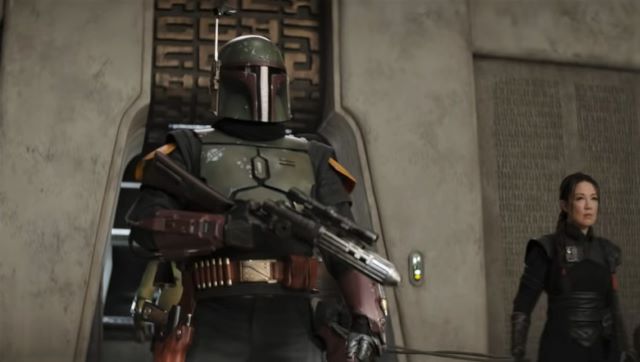
For many viewers, Star Wars is synonymous with characters like Luke Skywalker and Darth Vader, embodiments of heroism and villainy whose actions have steered the course of this long-running fantasy series.
Then there are the Star Wars fans whose admiration runs a bit deeper, to the ranks of supporting characters whose intentions are not so easily categorised, and whose screen time can be measured in mere minutes.
Take the case of Boba Fett, an armoured mercenary introduced to most moviegoers in the 1980 Star Wars sequel, The Empire Strikes Back. In that film, he appeared in only a few scenes, as an accessory to Vader’s plot to lure Skywalker into a fateful showdown. Fett resurfaced in Return of the Jedi (1983), in which he met a quick and mortifying demise. (Or so it seemed.)
Even so, Fett enjoys a unique place in the collective psyche of Star Wars devotees, who have spent years imagining his further exploits and building an iconography around his austere masked visage.
Now, after decades’ worth of books, games, toys, and other merchandise helped keep the Boba Fett cult alive, the character will be the protagonist of his own Star Wars tale. The Book of Boba Fett charts a new course for him after the events of Return of the Jedi.
For the people who make Star Wars and the people who consume it, the culmination of Fett’s cultural journey from a peripheral player to a significant figure in the franchise is both validating and a bit baffling.
To many, Fett’s ascent illustrates how Star Wars has evolved over its history, telling more kinds of stories and giving more characters their moments in the spotlight — even if Fett’s particular appeal is steeped in mystery, and his identity defined primarily by reticence and actions implied but never shown.
“It isn’t so much the things that Boba Fett does in the films — it’s the things that Boba Fett has done,” said Charles Soule, author of the current Star Wars comic-book series. “Everybody that encounters Boba Fett is either intimidated by him, interested in him or wants to use him for the hardest possible jobs,” Soule explained. “He has this incredibly vivid place in the Star Wars galaxy outside of his appearances onscreen.”
Fett owes his origins to a certain amount of accident and happenstance. After the runaway success of Star Wars in 1977, its writer and director George Lucas began preparing for a sequel. Among the characters he envisioned was a new, enhanced class of the Stormtroopers employed by the nefarious Empire.
Joe Johnston, the future filmmaker who was an art director on The Empire Strikes Back, worked with concept artist Ralph McQuarrie to design the costumes for these super-troopers, creating a suit of armour and a helmet with a narrow eye visor.
Johnston, who later directed films like Jumanji and Captain America: The First Avenger, said that Lucas scaled back his plans over budgetary concerns. “George said we couldn’t afford an army of super-troopers, but we’ve got this new suit,” Johnston recalled. “He said, ‘Let’s make him a bounty hunter.’ OK, sounds cool.”
At Lucas’ direction, Johnston fine-tuned the new character, taking inspiration from the nameless stranger played by Clint Eastwood in Sergio Leone’s spaghetti westerns. The bounty hunter’s armour was given weathered colours and dents suggesting his past conflicts. (He was also, briefly, given a serape until it was determined that it got in the way of his weapons.) Boba Fett was born.
“He was neither a hero nor a villain,” Johnston said. “You could hire Boba Fett to do whatever job you wanted him to do.”
According to Pete Vilmur, the head of fan relations at Lucasfilm, Fett made his public debut in September 1978 at a county parade in San Anselmo, California, where he was overshadowed by Darth Vader.
Fett also appeared as an animated character later that fall in the notorious Star Wars Holiday Special, a poorly received TV program that was never rebroadcast. A promotional offer aimed at collectors of Star Wars toys allowed them to send away for a Boba Fett action figure before he appeared in the movies. Nothing about the character’s life or history was revealed.
“For people who didn’t grow up at that time, it’s hard to understand how starved we were for information about Star Wars,” said Jon Favreau, the creator of The Book of Boba Fett, and the Disney+ series from which it was spun off, The Mandalorian.
“You’d buy magazines with photo spreads,” he said. “You’d buy the toys and play with them. By the time Boba Fett appeared onscreen, we felt like we already knew him.”
Fett was seen, sparingly, in The Empire Strikes Back, including a scene where he stands among a group of bounty hunters that Vader has assembled to hunt down the roguish Han Solo. Vader singles out Fett for a brief instruction: “No disintegrations.” (“As you wish,” Fett mutters in reply.)
That interaction alone was enough to stoke the imaginations of many Star Wars viewers. “You’re like, OK, why is this the guy that Darth Vader, the crème de la crème of tough guys, is singling out? What’s so special about him?” Soule said.
In Return of the Jedi, a temporarily blinded Solo accidentally triggered Fett’s jetpack, sending the bounty hunter crashing into the side of a barge, and then into the waiting mouth of a Sarlacc monster. But not even the character’s apparent death could diminish his fans’ enthusiasm for him.
With no more Star Wars movies on the horizon, Fett’s admirers continued to speculate about the identity of the man never seen beneath that daunting armour.
“With Boba Fett, less is more,” Vilmur said. “Things are hidden and unknown. We fill in the shadows with our own ideas of who he might be and what he’s capable of.”
“He fuses all these genres — the crime movie, the Western, the samurai, the medieval legend — into one iconic image,” said Kasdan, who wrote the spinoff movie Solo: A Star Wars Story with his father. “I could intellectualise it to no end,” Kasdan said. “But the flip side of it is that it made for a fantastic action figure.”
Further cartoons, comics, short stories, and novels authorised by Lucasfilm over the years continued to fill in Fett’s past adventures; others supplied tales in which the character escaped the Sarlacc monster and continued his mercenary work.
And as the production of Star Wars movies resumed, Fett continued to find his way into them. The character was given another brief appearance added in a 1997 rerelease of the original film, now titled Star Wars: Episode IV — A New Hope.
A 2002 prequel film, Star Wars: Episode II — Attack of the Clones, established that the young Boba (played by Daniel Logan) was both the son and a clone of another fearsome soldier for hire called Jango Fett (Temuera Morrison).
The animated series Star Wars: The Clone Wars, which made its debut in 2008, provided further details about young Boba’s boyhood. “We wanted to delve into what made him the character we saw later in Empire,” said Dave Filoni, a writer, supervising director, and executive producer of Clone Wars. “Once his father was killed by a Jedi, it changed him significantly. You realised that he would want to mirror his father — become his father and take his armour.”
Soule, the comic-book author, said that compared to other Star Wars characters whose life stories have been filled in almost entirely by the movies, Fett still had many tantalisingly unexplored areas in his personal history. “There are characters who we have seen a lot of, and it’s hard to find the places where there’s much capital still left,” he said. “Then there are characters whose bank accounts haven’t been drawn down very much. There’s a lot of capital left in Boba Fett’s account.”
But the popularity of Fett among Star Wars creators has meant that not everyone who wants him can have a piece of him. Kasdan said that while he might have liked to feature the character in Solo, he was told by Lucasfilm that “Boba was always off limits because he was in development elsewhere.”
The initial efforts of the studio to create a Boba Fett movie did not come to fruition. But as Favreau and his collaborators began devising The Mandalorian, which premiered in 2019, they found themselves irresistibly drawn to a bounty-hunter protagonist who lived by a personal code, and wore armour similar to Fett’s.
As Favreau explained, “We tried to reconnect with the roots of what inspired George. A Mandalorian character lends itself to simple storytelling, in the spirit of the Westerns that were so popular on television in the generation of my father.”
After another enigmatic cameo — little more than a cape and a pair of boots — in the debut season of The Mandalorian, Fett (now played by Morrison) returned in the series the following year.
The second-season finale of the show set up the story for The Book of Boba Fett, on which both Favreau and Filoni are writers, directors, and executive producers. (Asked if the new series would explain how Fett survived his encounter with the Sarlacc, Filoni replied, “It’s so much more exciting to watch how everything plays out than for me to explain it.”)
Favreau, who directed the first two Iron Man movies for Marvel, said that the interconnectedness of that studio’s cinematic universe has accustomed viewers to seeing “characters within the same franchise making appearances across several different properties.” He added, “Star Wars is something where the audience is just as much a component as what you’re putting out there as a filmmaker.”
The narrative push to provide Fett with an established identity and a back story that explains his motives has not delighted every Star Wars fan. “I never would have shown his face,” Johnston said. “I would never have had an actor underneath where he takes the helmet off and you see who it is. I think that eliminates a lot of the mystery. Before that helmet comes off, he can be anybody.”
But Filoni said that streaming television has taught viewers to expect that all the branches of a narrative should be available to them the moment they sit down to watch any part of it.
Compared to when he first saw Star Wars in a movie theater, Filoni said, “They can watch A New Hope, hear Obi-Wan talk about the Clone Wars, and they’re just one toggle away from watching it. I came out of the theater going, ‘Dad, how come you brought me to the fourth one? Why’d we miss the first three?’”
The Book of Boba Fett will premiere in India today on Disney+ Hotstar.
OVERVIEW
OnMyWay Is The #1 Distracted Driving Mobile App In The Nation!
OnMyWay, based in Charleston, SC, The Only Mobile App That Pays its Users Not to Text and Drive.
The #1 cause of death among young adults ages 16-27 is Car Accidents, with the majority related to Distracted Driving.
OnMyWay’s mission is to reverse this epidemic through positive rewards. Users get paid for every mile they do not text and drive and can refer their friends to get compensated for them as well.
The money earned can then be used for Cash Cards, Gift Cards, Travel Deals and Much, Much More….
The company also makes it a point to let users know that OnMyWay does NOT sell users data and only tracks them for purposes of providing a better experience while using the app.
The OnMyWay app is free to download and is currently available on both the App Store for iPhones and Google Play for Android @ OnMyWay; Drive Safe, Get Paid.
Download App Now – https://r.onmyway.com
Sponsors and advertisers can contact the company directly through their website @ www.onmyway.com.













